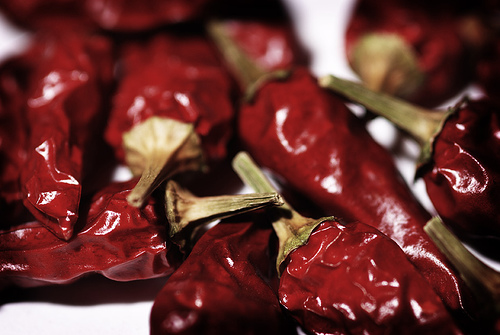 Getting hot in here.Photo: Josh KelloggClimate change is the issue of our time. Its ill effects will fall heaviest on the people who have least contributed to it: billions in the global south. But no one will escape the impact of the warming climate, and one place it will manifest most obviously is on our plates. If we look at chile peppers, for example, it’s easy to see how the negative effects of climate change have affected the food on our plates and the farmers behind that food. In their new book, Chasing Chiles: Hot Spots Along the Pepper Trail, authors (and self-titled “gastronauts”) Gary Nabhan, Kurt Michael Friese, and Kraig Kraft clear a path in the rubble on their beloved “spice ship,” with the chile pepper as their guide. You’ll never see hot sauce in the same way again. In this interview, the three spoke as a team, so I’ve conglomerated their answers to reflect their pepper-infused mind-meld.
Getting hot in here.Photo: Josh KelloggClimate change is the issue of our time. Its ill effects will fall heaviest on the people who have least contributed to it: billions in the global south. But no one will escape the impact of the warming climate, and one place it will manifest most obviously is on our plates. If we look at chile peppers, for example, it’s easy to see how the negative effects of climate change have affected the food on our plates and the farmers behind that food. In their new book, Chasing Chiles: Hot Spots Along the Pepper Trail, authors (and self-titled “gastronauts”) Gary Nabhan, Kurt Michael Friese, and Kraig Kraft clear a path in the rubble on their beloved “spice ship,” with the chile pepper as their guide. You’ll never see hot sauce in the same way again. In this interview, the three spoke as a team, so I’ve conglomerated their answers to reflect their pepper-infused mind-meld.
Q. Your new book, Chasing Chiles: Hot Spots Along the Pepper Trail looks at both the future of place-based foods and the effects of climate change on agriculture through the lens of the chile pepper. Why the chile pepper, as opposed to, say, corn?
A. There is an easy enough metaphor behind the heat of chiles and the heat of global warming, but really it’s much more than that. Chiles are grown all over the world and have become the hallmarks of certain cuisines. There exists a tremendous amount of diversity in the shapes, tastes, and ecological adaptations of the chiles that reveal much to us about how climate change is affecting place-based foods. But there is also great diversity in how people process and consume chile peppers. They fire up people’s imaginations (and taste buds) in ways that corn, wheat, or soy can’t do. Plus we happen to love the hot little suckers.
Q. Over a year-long journey traveling in the U.S. and Mexico, the three of you — an agroecologist, a chef, and an ethnobotanist — came face to face with the realities of once thriving farms and producers now in danger of losing chiles integral to their local cultural identity. What chiles did you focus on, and why?
A. Of course there are many more heirloom chiles than the handful we focused on in the book. We happened to choose these because they are integral parts to the places we visited. Chimayos in New Mexico, Chiltepines in Sonora, Habaneros in the Yucatan, Tabascos in Louisiana, Datils in St. Augustine, Fish Peppers near Chesapeake Bay, even Beaver Dam peppers in Wisconsin and Jimmy Nardellos in Connecticut — each chile pepper has its own poignant (and pungent!) story and a role in local culture and cuisines.
Q. How did the three of you come together to work on this project?
A. It started with a conversation between Gary and Kurt, about following the pepper trail — tracing how this simple nightshade made its way from Central America all the way to Southeast Asia. Gary admired the vitality of Kraig’s field work and enthusiasm for chile cultures, so we invited him on board the “spice ship.” For our first orbit, we decided to focus on plant hunting for peppers in North America. But we hope to take the spice ship around the world someday.
Q. I didn’t realize Tabasco™ sauce was once created solely from Tabasco™ peppers grown at the McIllhenny company production site in Avery Island, Louisiana. And while the company still produces all of their seed peppers in the original location, currently their peppers are farmed in over 165 countries worldwide. In your book, you talk about how this could be seen as a model for achieving resilience in the face of climate change. Can you speak more to this issue?
A. The key idea here is indeed resilience, the capacity to survive change. How do we adapt our culinary traditions and our cultures to deal with the changes that come with global warming without compromising identity and authenticity?
For those who saw the vulnerability at Avery Island of having all their chiles in one basket, it was a very easy decision. Diversify where Tabasco would be grown, or risk losing everything. Yet in implementing some viable bet-hedging strategies, the McIllhennys admirably maintained links to tradition. All their peppers — wherever they are grown — are mashed with salt mined from Avery Island and all the seed for all the Tabasco grown elsewhere is maintained and propagated at Avery Island. Forced to make a change, this community figured out a way to adapt which maintained some sense of place and tradition.
Q. How has the sustainable food movement and increased interest in terroir affected small-scale chile growers in the U.S.?
A. Because of the resurgence of direct marketing by small-scale growers, there is more vegetable diversity offered today at farmers markets, through CSAs and in grocery stores than a dozen years ago. Terroir — the taste of place — is still better known in wines, tequilas, maple syrup, and coffees than in vegetables and fruits, but growers and connoisseurs know it has been there all along. This, however, is the first book of many recent ones discussing the taste of place which recognizes that terroirs as we know them are being dramatically scrambled by climate change. [See Gary Nabhan’s Grist post on “global weirding and the scrambling of terroir.”]
Q. What is the most delicious chile dish each of you have ever had, and where did you eat it?
A. Kurt: Of course I can’t pick just one, but for me the most delightful recent discovery was learning about Xnipec in the Yucatan. It’s a kind of pico de gallo with habanero chiles and sour orange juice, sometimes they add cabbage. The name comes from the Mayan for “dog’s nose,” because when you eat it, it may make your nose run from the heat.
Kraig: Only one? A green chile cheeseburger — either in my parent’s backyard, or at the Owl Bar and Cafe in San Antonio, New Mexico.
Gary: So many chiles, so little time … My two favorite traditional chile products are the Halaby pepper from Aleppo, Syria and chile Coban from Guatemala, but my favorite dishes is Ysleta green chile stews served near El Paso and my own chiltepin-vanilla bean ice cream, which is so hot you have to eat more of it to cool yourself down …
Q. How can other chile lovers join the movement to protect and support heirloom chiles and their farmers?
A. A mutual friend of ours, Poppy Tooker, has coined the phrase “You’ve got to eat it to save it!” which is so true. The more of a market that exists for heirloom and local foods — not just chiles — the better their chance for survival.
For those who are gardeners, the best thing they can do is to grow and save and share heirloom seeds at home. In addition, there are some great organizations doing important work to protect biodiversity in our food system, including chiles. Native Seeds/SEARCH, Seed Savers Exchange, and Southern Exposure Seed Exchange are among the many nonprofits that work to conserve chile seed stocks and their related cultural legacies. And of course, support the chile farmers themselves and the many nonprofits working to save food biodiversity, such as Slow Food and its Ark of Taste.



